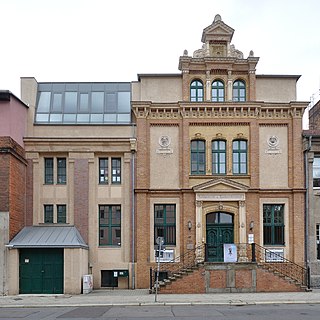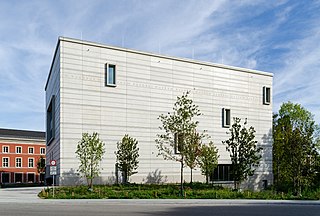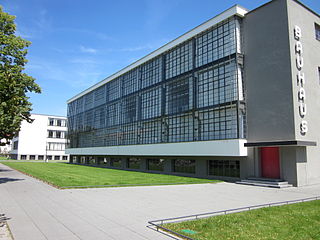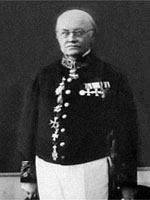Related Research Articles

The Duchess Anna Amalia Library in Weimar, Germany, houses a major collection of German literature and historical documents. In 1991, the tricentennial of its opening to the public, the Ducal Library was renamed for Duchess Anna Amalia. Today, the library is a public research library for literature and art history. The main focus is German literature from the Classical and the late Romantic eras. The ducal library was supplied, among others, by the bookseller Hoffmann from Weimar as well as with publications from France and Europe by the Strasbourg publishing house Bauer, Treuttel and Würtz. The library was inscribed on the UNESCO World Heritage List as part of the Classical Weimar site because of its testimony to the global cultural importance of Weimar during the late 18th and early 19th centuries during the Weimar Classicism movement.
Lorenz is an originally German name derived from the Roman surname Laurentius, which means "from Laurentum".

The Haus am Horn is a domestic house in Weimar, Germany, designed by Georg Muche. It was built for the Bauhaus Werkschau exhibition which ran from July to September 1923. It was the first building based on Bauhaus design principles, which revolutionized 20th century architectural and aesthetic thinking and practice.

The Kunsthalle Mannheim is a museum of modern and contemporary art, built in 1907, established in 1909 and located in Mannheim, Germany. Since then it has housed the city's art collections as well as temporary exhibitions – and up to 1927 those of the local Mannheimer Kunstverein as well as its administration.

A Kunstgewerbeschule was a type of vocational arts school that existed in German-speaking countries from the mid-19th century. The term Werkkunstschule was also used for these schools. From the 1920s and after World War II, most of them either merged into universities or closed, although some continued until the 1970s.

The Museum im Kulturspeicher in Würzburg displays art from the 19th century to the present. It is located in a converted river-side warehouse since 2002. After the previous director Marlene Lauter retired after nearly 30 years of service, the art historian Luisa Heese took over as director of the museum on September 1, 2020

The Goethe-Nationalmuseum is a museum devoted to the German author Johann Wolfgang von Goethe, in the town of Weimar in Germany. Originally comprising the Goethe House, where Goethe lived intermittently for 50 years from 1782 to 1832, the museum was founded on 8 August 1885 as a result of the will of Goethe's last living heir, his grandson Walther von Goethe, who left the Goethe House to the state.

The Klassik Stiftung Weimar is one of the largest and most significant cultural institutions in Germany. It owns more than 20 museums, palaces, historic houses and parks, as well as literary and art collections, a number of which are World Heritage Sites.

Bazon Brock is a German art theorist and critic, multi-media generalist and artist. He is considered a member of Fluxus. He was a professor of aesthetics at the Hochschule für bildende Künste Hamburg, the University of Applied Arts Vienna and the University of Wuppertal.

The Bauhaus Museum Weimar is a museum dedicated to the Bauhaus design movement located in Weimar, Germany. It presents the Weimar collections of the State Bauhaus, which was founded in the town in 1919. The museum is a project of the Klassik Stiftung Weimar and is located near the Weimarhallenpark. Originally opened in 1995, it is now housed in a new building since April 2019.

Schloss Weimar is a Schloss (palace) in Weimar, Thuringia, Germany. It is now called Stadtschloss to distinguish it from other palaces in and around Weimar. It was the residence of the dukes of Saxe-Weimar and Eisenach, and has also been called Residenzschloss. Names in English include Palace at Weimar, Grand Ducal Palace, City Palace and City Castle. The building is located at the north end of the town's park along the Ilm river, Park an der Ilm. It forms part of the World Heritage Site "Classical Weimar", along with other sites associated with Weimar's importance as a cultural hub during the late 18th and 19th centuries.
Ulrike Theusner( born 1982 in Frankfurt, Germany) is a German artist working primarily in drawing and printmaking. She studied at École Nationale Supérieure d'Arts à la Villa Arson in Nice, France and graduated in 2008 from Bauhaus University in Weimar, Germany. Amongst others, her work was exhibited in groupshows at Kunsthalle Darmstadt, Musée des Beaux-Arts de Nice, Neues Museum Weimar and several solo shows in New York, Berlin, Frankfurt, Toulouse, Paris and Shanghai. She lives and works between Weimar and Berlin.

Kurt Martin was a German art historian. His career began in 1927 as curator of the Baden State Museum Karlsruhe. From 1934 to 1956, he was director of the Staatlichen Kunsthalle Karlsruhe. In 1940 he was appointed Head of the Municipal Museums of Strasbourg as well as Chief Commissioner of the Alsatian Museums. In 1956 he became Director of the Karlsruher Kunstakademie, and in 1957 General Director of the Bayerischen Staatsgemäldesammlungen. He was also a professor of art history.

Alma Siedhoff-Buscher, born Alma Buscher, was a German designer. She trained at the Reimann School in Berlin, the Unterrichtsanstalt des Kunstgewerbemuseums Berlin and the Bauhaus.

Bauhaus and its Sites in Weimar, Dessau and Bernau are World Heritage Sites in Germany, comprising six separate sites which are associated with the Bauhaus art school. It was designated in 1996 with four initial sites, and in 2017 two further sites were added.

Rolf Dieter Lauter is a German art historian, curator, and art advisor.
Danica Dakić in Sarajevo) is a Bosnian artist and university professor. She works primarily with video art, installation and photography. Her works have been widely exhibited, including at documenta 12 (2007) and at the 58th Venice Biennale (2019), where she represented Bosnia and Herzegovina. Dakić lives and works in Düsseldorf, Weimar, and Sarajevo.

Walter Passarge was a German art historian and Director of the Städtischen Kunsthalle Mannheim.

Carl Heinrich Ruland was a German art and literary historian. He served as private secretary and librarian to Albert, Prince Consort, from 1859 until the prince's death in 1861.

Ulrike Lienbacher is an Austrian artist. She works in various media and lives in Salzburg and Vienna.
References
- ↑ Klassik Stiftung Weimar. "Dr. Ulrike Lorenz: Präsidentin der Klassik Stiftung Weimar".
- ↑ Der Tagesspiegel: Ulrike Lorenz wird Chefin der Klassik Stiftung Weimar Retrieved December 19, 2019